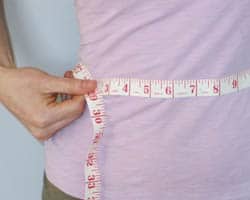
Have you ever noticed an extremely lean person with back or belly fat, or a heavy person with a flat belly? When we gain weight, we don’t gain it everywhere simultaneously. Where we store fat can be attributed to a number of factors from genetics to hormonal imbalances. While we should be concerned about our total percentage of body fat, where fat sits on the body can give us some clues about our hormonal activity.
Many studies — some of which were initiated as a result of strength coach Charles Poliquin’s research — have shown that changes in the production or clearance of certain hormones are correlated to an increase in weight and fat distribution. While research continues, here’s a glance at what’s known so far:
Thighs/buttocks: The pear-shaped body, or fat stored in the thighs and gluteal area indicate high estrogen. Many women argue that their body shape was genetically inherited – and so were the abnormally high estrogen levels. To detoxify estrogen, consume cruciferous vegetables containing indole-3-carbinol such as broccoli, cauliflower, cabbage, and Brussels sprouts at least three times each week. Supplementation with indole-3-carbinol may be recommended. For exercise, an interval weight training protocol of high repetitions (10-15) and short rest intervals (about 30 seconds between sets) is suggested.
Triceps: For the fat on the back of your arms, stress-combating adaptogenic herbs such as licorice root, ginseng and rhodiola are recommended, as high stress levels tend to lower androgen levels by stealing pregnenolone to make cortisol instead of the androgen DHEA. Adaptogens help the body handle stress better and can reduce cortisol levels.
Upper back and lower back: These sites are related to blood sugar management, representing poor insulin sensitivity and carbohydrate intolerance. Controlling blood sugar levels with more frequent meals, reduced carbohydrate intake and low-GI food choices is critical. Fenugreek, cinnamon, lemon, and increasing fiber intake are also recommended.
Middle back: Fat stored in the middle back is correlated to thyroid hormone levels. Iodine-rich sea vegetables stimulate the thyroid gland.
Belly: The belly is the infamous cortisol site. Fat levels here can be high despite low overall body fat. Reduce cortisol levels by dealing with stress and by restricting the consumption of caffeine and sugar. There is a direct relationship between abdominal fat and stress. When stressed, cortisol is secreted which activates fat storage enzymes in cells.
Fat stored around the waist poses the greatest risk to health compared with other sites of fat storage. Measure the waist level with the belly button and the hips at their widest point. Then, determine the ratio by dividing the waist girth by the hip girth (waist girth divided by hip girth = waist/hip ratio). For men, the waist:hip ratio should read below 1.00, and below 0.80 for women.










